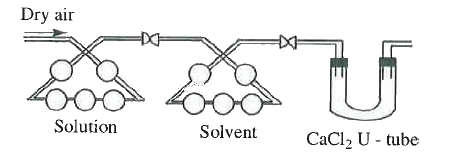A stream of dry air was passed through a bulb containing a solution of 7.5 g of a compound dissolved in 75 g of water and then through another bulb containing pure water. The loss of mass in the first bulb was 2.81 g and in the second bulb was 0.054 g. Calculate the molecular mass of the compound. Solution in Kannada
M2=P0(W2M1)(P0−P)W1
OR
M2=W2M1W1×(P0P0−P)
Total loss in mass of solution bulb and the solvent bulbLoss in mass of solvent bulb
= 7.5×1875×2.8640.054
M2=95.47.
Topper's Solved these Questions
- SOLUTIONSBOOK - OSWAAL PUBLICATIONCHAPTER - SOLUTIONSEXERCISE - TOPIC - 3 COLLIGATIVE PROPERTIES , DETERMINATION OF MOLAR MASS, ABNORMAL MOLAR MASS, VAN.T HOFF FACTOR (VERY SHORT ANSWER TYPE QUESTIONS )
16 Videos
- SOLUTIONSBOOK - OSWAAL PUBLICATIONCHAPTER - SOLUTIONSEXERCISE - TOPIC - 3 COLLIGATIVE PROPERTIES , DETERMINATION OF MOLAR MASS, ABNORMAL MOLAR MASS, VAN.T HOFF FACTOR (SHORT ANSWER TYPE QUESTIONS)
11 Videos
- SOLUTIONSBOOK - OSWAAL PUBLICATIONCHAPTER - SOLUTIONSEXERCISE - TOPIC - 2 VAPOUR PRESSURE, RAOULT.S LAW , IDEAL AND NON-IDEAL SOLUTIONS ( SHORT ANSWER TYPE QUESTIONS )
12 Videos
- SOLID STATEBOOK - OSWAAL PUBLICATIONCHAPTER - SOLID STATEEXERCISE - TOPIC -2 (SHORT ANSWER TYPE QUESTIONS)
21 Videos
- Solved Paper BOOK - OSWAAL PUBLICATIONCHAPTER - Solved Paper EXERCISE - Exercise
60 Videos
Similar Questions
What is the effect of rise in temperature on the solubility of gases in liquids?
View SolutionDefine isotonic solution. What happens when the blood cell is dipped in a solution containing more than normal saline concentration?
View SolutionGive two general characteristics of an ideal solution of two liquids.
View SolutionGive two differences between p-type & n-type semiconductors.
View SolutionName the law behind the dissolution of CO2 gas In soft drinks under high pressure.
View SolutionDry air was passed successively through a solution of 5g of a solute in 180g water and then through pure water. The loss in weight of solutionwas 250g and that of pure solvent 0.04g . The molecular weight of the solute is
View SolutionDry air is passed through a solution containing 10 g of the solute in 90 g of water and then through pure water. The loss in weight of solution is 2.5 g and that of pure solvent is 0.05 g. Calculate the molecular weight of the solute.
View SolutionDry air was passed successively through a solution of 5 g of a solutte in 80 g of water and then through pure water. The loss in mass of solution was 2.5 g and that of pure solvent was 0.04 g The molecular mass of the solute is :
View SolutionA current of dry air was passed first through a series of bulbs containing a solution of C_(6)H_(5) - NO_(20 in ethanol of molality 0.725 and then through a series of bulbs containing pure ethanol. (T = 284 K) loss in weight of the solvent bulbs was 0.0685 g. Calculate the loss in weight of the solution bulbs.
View SolutionA Current of dry air was first passed through the bulb containing solution of 'A' in water and then through the bulb containing pure water. The loss in mass of a solution bulb is 1.92g gm. Where as that in pure water bulb is 0.08g, then mole fraction of 'A' is.
View SolutionA Current of dry air was first passed through the bulb containing solution of 'A' in water and then through the bulb containing pure water. The loss in mass of a solution bulb is 1.92g gm. Where as that in pure water bulb is 0.08g, then mole fraction of 'A' is.
View SolutionA current of dry air was bubbled through a bulb containing 30 g of an organic compound in 200g of water , then through a bbulb at the same temperature, containing water and finally through a tube containing anhydrous CaCl_(2) the loss in mass of bulb containing water was 0.03 g and gain in mass of CaCl_(2) tube was 2g, then molecular mass of organic compound is
View SolutionA current of dry air is passed through the above apparatus containing two sets of bulbs . One set of bulbs is filled with the solution and second with the solvent . Finally that is attched with a U-tube containing CaCl2, which is very efficient in absorbing the water vapour. Passing of dry air through all these three causes some change in weight.

Dry air was passed through solution of 5g of solute in 80g of water and the passed thriugh pure water . The loss in weight of solution was 2.5g and that of pure water was 0.04g . The molecular mass of solute is
View SolutionSet A of glass bulbs contain a solution of 1 mole of glucose in 24 mol of water . Another set B of bulbs contain pure water . All bulbs are maintanined at the same temperature and are interconnected as then through pure water in set B. The solution is found to suffer a mass loss of W_(1)g and water suffers a mass loss of W_(2)g afetr certain period of time . If p_(s) and P^(0) are the vapour pressure of solution and water respectively at the temperature of experiment , then which of the following is correct ?
View SolutionSet A of glass bulbs contain a solution of 1 mole of glucose in 24 mol of water . Another set B of bulbs contain pure water . All bulbs are maintanined at the same temperature and are interconnected as then through pure water in set B. The solution is found to suffer a mass loss of W1g and water suffers a mass loss of W2g afetr certain period of time .

If vapour pressure of water is 50 mm Hg at the temperature of experimeter, the vapour pressure of solution will be :
View Solution
